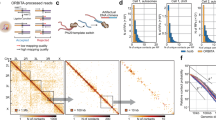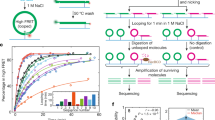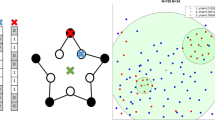Abstract
Although an increasing number of detailed DNA sequence studies are being carried out, little is known about the long-range organization of the eukaryotic genome in relation to chromosomal organization and to functional units of transcription, replication, meiotic crossing-over and nuclear architecture. Based on electron microscope (EM) observations of partially denatured DNA of duck, mouse and rat, we have recently reported a systematic punctuation of DNA by early melting zones (‘A + T-rich linkers’)1 ∼800 base pairs (bp) long which are either clustered or at intervals of 10–40 kbp. In an attempt to correlate this feature with the organization of specific genes, we examined cloned genomic DNA from chick and Drosophila, including the globin gene family, and an isolated high-molecular-weight mRNA. We show here that the chick α-globin gene cluster is framed by a cluster of A + T-rich linkers at the 5′ end and by an isolated linker at the 3′ end which maps close to the sites of transcription termination and DNase hypersensitivity. The resulting frame of ∼15 kbp correlates well with the maximum size of globin gene transcripts found at the pre-mRNA level. The β-globin gene cluster is also framed, 5′ by a single A + T-rich linker and 3′ a cluster of four linkers. In Drosophila, the single mRNA sequence of ∼3.3 kbp for the ecdysone-inducible P1 protein is similarly delimited by A + T-rich linkers. A + T-rich linkers thus seem to define domains of the eukaryotic genome which may correlate with putative functional units. The specific organization observed in total DNA of duck, mouse, rat, man, chicken and Drosophila is confirmed in gene-specific cloned genomic DNA.
This is a preview of subscription content, access via your institution
Access options
Subscribe to this journal
Receive 51 print issues and online access
$199.00 per year
only $3.90 per issue
Buy this article
- Purchase on Springer Link
- Instant access to full article PDF
Prices may be subject to local taxes which are calculated during checkout
Similar content being viewed by others
References
Moreau, J., Matyash-Smirniaguina, L. & Scherrer, K. Proc. natn. Acad. Sci. U.S.A. 78, 1341–1345 (1981).
Dodgson, J. B., Strommer, J. & Engel, J. D. Cell 17, 879–887 (1979).
Dolan, M., Sugamman, B. J., Dodgson, J. B. & Engel, J. D. Cell 24, 667–677 (1981).
Engel, J. D. & Dodgson, J. B. Proc. natn. Acad. Sci. U.S.A. 77, 2596–2600 (1980).
Weintraub, M., Larsen, A. & Groudine, M. Cell 24, 333–344 (1981).
Lepesant, J.-A., Garen, A., Kejzlarova-Lepesant, J., Maschat, F. & Rat, L. ICN-UCLA Symp. Vol. 14 (eds Maniatis, T. & Axel, R.) (Academic, New York, 1979).
Lepesant, J.-A. et al. Molec. appl. Genet. (in the press).
Maschat, F. thesis, Univ. Paris VII (1981).
Firtel, R. A., Timm, R., Kimmel, A. R. & McKeow, M. Proc. natn. Acad. Sci. U.S.A. 76, 6206–6210 (1979).
Grosschedl, R. & Birnstiel, M. L. Proc. natn. Acad. Sci. U.S.A. 77, 7102–7106 (1981).
Reynaud, C.-A., Imaizumi-Scherrer, M.-T. & Scherrer, K. J. molec. Biol. 140, 481–504 (1980).
Hofer, E. & Darnell, J. E. Jr Cell 23, 585–593 (1981).
Author information
Authors and Affiliations
Rights and permissions
About this article
Cite this article
Moreau, J., Marcaud, L., Maschat, F. et al. A + T-rich linkers define functional domains in eukaryotic DNA. Nature 295, 260–262 (1982). https://doi.org/10.1038/295260a0
Received:
Accepted:
Issue Date:
DOI: https://doi.org/10.1038/295260a0
This article is cited by
-
Modulation of chromatin by MARs and MAR binding oncogenic transcription factor SMAR1
Molecular and Cellular Biochemistry (2010)
-
Characterization of the chromatin structure in the upstream region of the chicken alpha-globin gene domain
Molecular and General Genetics MGG (1994)
-
Modular transposition and the dynamical structure of eukaryote regulatory evolution
Genetica (1992)
-
Polyadenylated RNA during DAPI-arrested regeneration of Tetrahymena cilia
Molecular and Cellular Biochemistry (1990)
-
Changes in DNA and surface properties of peripheral blood leukocytes in monkeys after whole-body ?-irradiation
Bulletin of Experimental Biology and Medicine (1989)
Comments
By submitting a comment you agree to abide by our Terms and Community Guidelines. If you find something abusive or that does not comply with our terms or guidelines please flag it as inappropriate.



